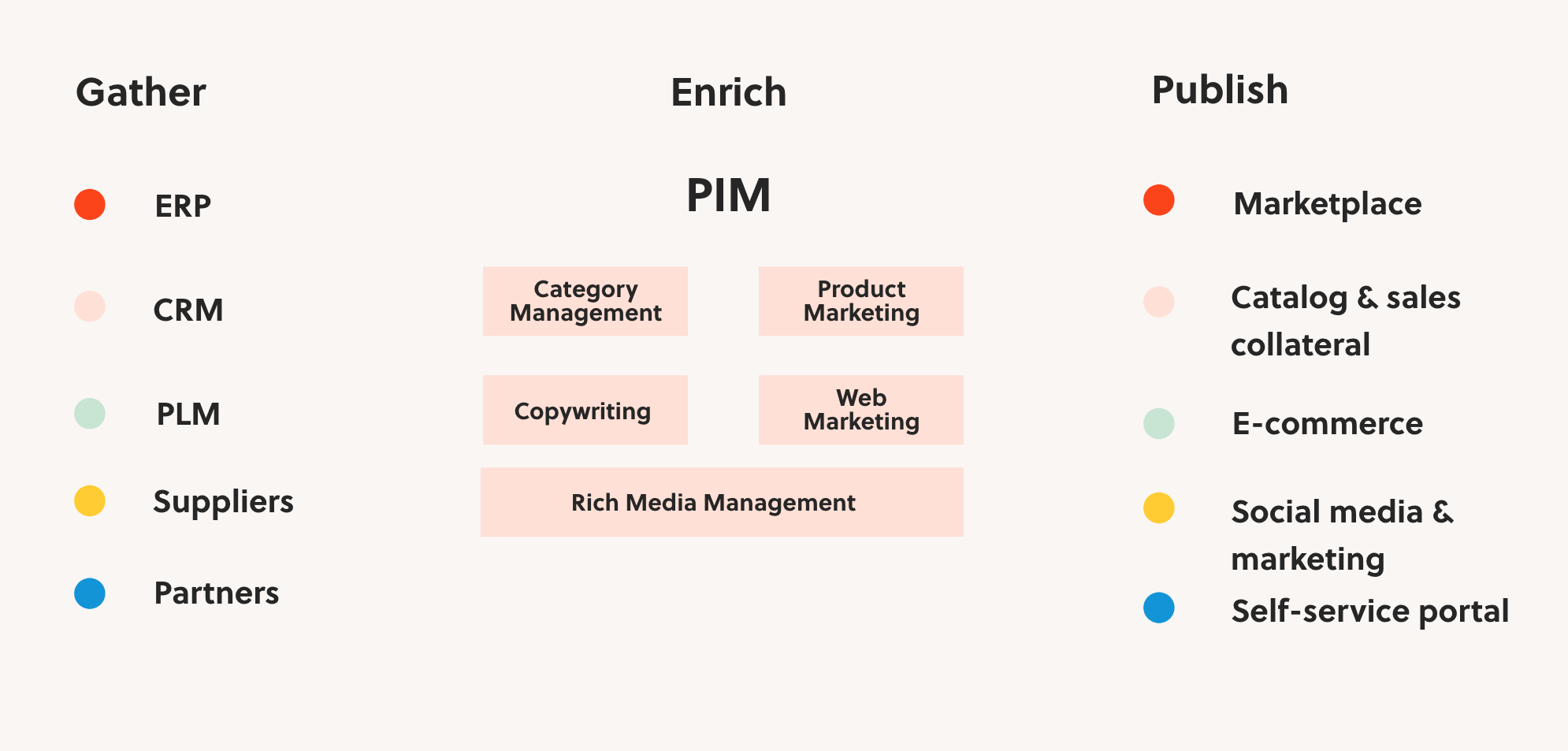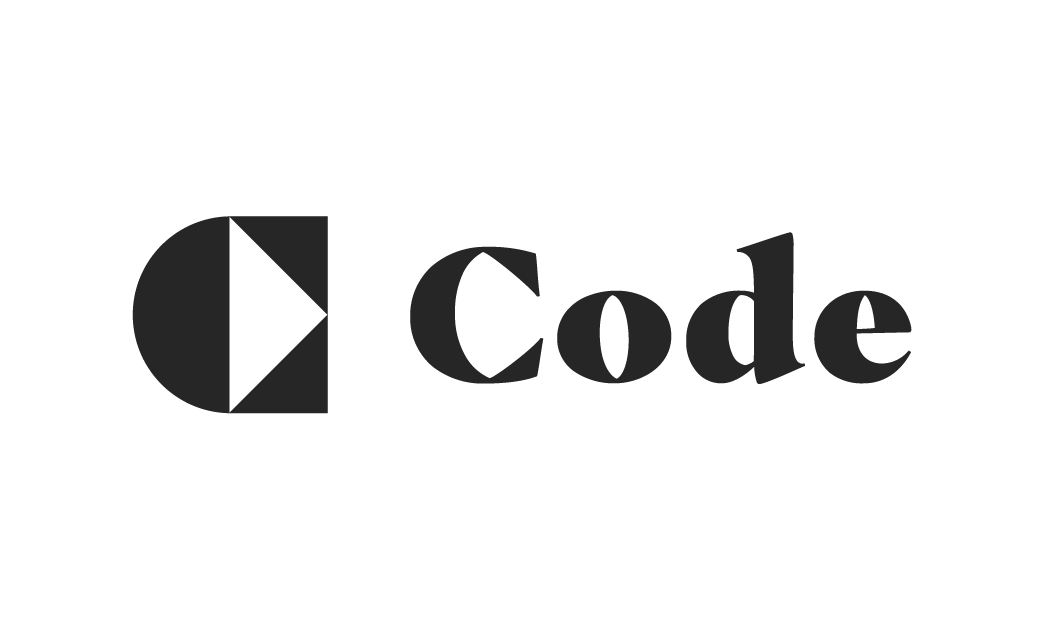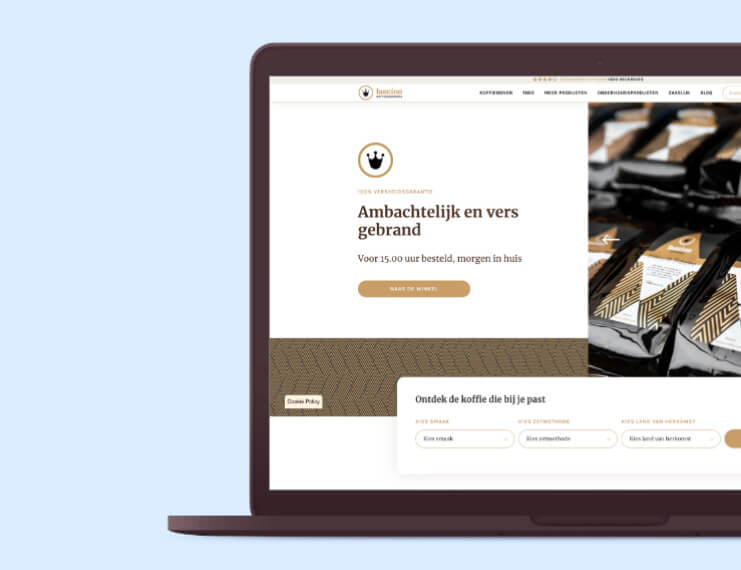What is a PIM?
PIM software makes your life easier by organising large, complex product information within a single platform. With a PIM, you bring together all the available data relating to a product, such as ERP data (weight, length, SKU, stock, etc), marketing data, SEO data and assets. From there you enrich this information easily and centrally. You can think of images, videos, SEO texts and translations. Afterwards, you can publish this product information quickly and efficiently to all your sales channels.
So in three steps, a PIM system helps you with:
1. Collecting product information.
2. The enrichment of product information.
3. The publication of product information on various channels.
Dominick Mastenbroek (Project Manager Code): "We see many of our customers using a PIM for product management. Besides effective product management, internationalisation, SEO, a shorter time-to-market and a better customer experience are the main reasons for choosing a PIM."
7 benefits of PIM systems
When properly deployed, a PIM has a lot of value for your brand. Below, we discuss seven benefits of PIM systems for e-commerce.
- Cost savings
With a Product Information Management system, you manage product data faster and more efficiently, saving time and cost.
- Streamlined cooperation
Different departments can all work with product information from the same central system. Think of marketers, SEO specialists, product specialists and category managers who, thanks to defined roles and workflows, can work independently, often in a specific order, on product information management.
- Better SEO
A PIM helps you strengthen your SEO position. Adding unique content to product pages ensures that search engines pick up your products faster. Enriching product data with title tags, meta tags, alt tags and product tags helps search engines - and thus your customers - find your products more effectively.
- Faster product launching
By setting up workflows within your PIM solution, new products with all relevant product information can be online within a day. Thanks to data validation, you can quickly determine which product data is complete and which is not. The result is a shorter time-to-market, which is very helpful when you have a broad and rapidly changing product range.
- Perfect for internationalisation
Do you want to sell internationally? Then a PIM is often a smart choice. You can easily manage all translations: not only of product information but also local versions of assets such as images and manuals. Your PIM system publishes the product information in the right web shop and new sales channels can be connected super fast.
- Better customer experience and fewer returns
You create trust by showcasing consistent (and error-free) product information on your omnichannel e-commerce channels. In addition, extensive product data gives your customers a better picture of the product, contributing to a positive customer experience and fewer returns.
- Channel-specific content increases conversion
With a PIM, you can optimize your product information and other assets per channel, increasing your conversion rate. For example: show different text and images on marketplaces, like Amazon, than on your webshop.
Checklist: do you need a PIM?
A PIM solution can be valuable for B2B and B2C brands in many industries and sizes. Implementing a PIM system requires a significant investment, so examining whether it's worth it carefully is essential. With the following checklist, we will help you on your way:
- You have a fast-changing, large product range, and many or different suppliers.
- Your company's product information is kept in different systems and is therefore fragmented.
- Maintaining your product data storage takes more time than necessary.
- You operate omnichannel with multiple channels such as your webshop, retail, marketplaces and social media and your products are distributed online in many different ways.
- Your product data is complex with a lot of information and related data. For example, you use many visual assets and extensive product information.
- It takes too long to introduce new products, causing you to be overtaken by competition.
- Your return rate is high, partly explained by incomplete or incorrect product information.
- You would like to internationalise and operate in multiple markets and languages.
Do you recognise one or more of these challenges for your business? Then it is worth contacting Code to discuss what a PIM can do for you and what this project might look like.
Choose the right PIM for your Shopify shop
Are you convinced that a PIM solution adds value to your Shopify webshop? Then it’s time to start researching the best PIM for Shopify.
There are many good PIM solutions on the market that integrate well with Shopify, like Sales Layer and Jasper PIM. For this article, we selected two of our most used PIM systems that integrate seamlessly with Shopify. Below, we list their main pros and cons.
Akeneo PIM
Over 41,000 companies use Akeneo's PIM software. Leading brands such as Carrefour, Sephora, Heineken, Universal Music Group, Adidas, and Renault use Akeneo's enterprise version. Code is one of the official Akeneo partners in the Netherlands and Germany. We have experience in guiding successful Akeneo implementations and can help you set up your PIM and provide you with training and support.
Advantages:
- Flexible setup for managing products and categories
- Extensive workflows allow you to set up processes efficiently
- Many advanced integration options
- Official Shopify partner
Disadvantages:
- Relatively expensive
- Prices go up quickly as channels (shops) and users increase.

Plytix PIM
Plytix has a clear target: 'To kill spreadsheets'. International brands working with this Danish PIM system include Skechers, Desenio and New Balance.
Advantages:
- Good solution for Small and Medium-sized (SMB) companies
- User-friendly interface
- Offers convenient product sheets
Disadvantages:
- No instant synchronization with Shopify

Quable PIM
Quable is a robust and feature-rich Product Information Management (PIM) platform designed to streamline e-commerce operations. Key features like fast import/export, AI-generated content, automatic translations, and visual workflow creation make Quable a smart choice for scaling your product management.
Advantages:
- Feature-rich Shopify connector limits the amount of custom integrations required.
- Native Multilingual (Shopify Markets) support
- Make.com integration allows for advanced moderation / enrichment possibilities
- Two way sync
Disadvantages:
- Limited bulk editing possibilities
.png?width=600&height=227&name=Quable-PIM-blog%20(1).png)
What does a PIM integration with Code look like?
When you chose the best PIM system, it’s time to implement the solution with your e-commerce platform. As an official Shopify Premier partner, we are well-equipped to help Shopify merchants with the integration of their PIM solution.
To ensure that you can make maximum use of functionalities, we integrate your PIM with various external data sources such as your ERP, WMS and Shopify store. Our team has the in-depth technical knowledge and experience required for this and will guide you through the following steps:
- We map out your e-commerce architecture and processes. In other words, the 'as-is' situation.
- Together, we define your ambitions, roadmap and requirements for the coming years. This creates a picture of the 'to-be' situation.
- We go through a PIM selection process and help you negotiate the best deal.
- We start the implementation of the chosen PIM system. We set up your PIM based on the data model that fits your requirements.
- We integrate your PIM solution with Shopify and optionally also with other systems (ERP, WMS). We do this with an existing connector or a custom integration.
- Congratulations: it's time to get your PIM system up and running! Code remains available to provide the support and further development you need to maximise the benefits of your PIM.
Our most important advice when starting a PIM implementation for your e-commerce? Think carefully beforehand about what you want to achieve with the system and which functionalities your PIM should contain. What do you really need? We often want too much. Discuss the end goal of the PIM system so that the architecture is clear, and involve all your stakeholders in the process.
Are you curious whether a PIM solution is a smart choice for your e-commerce brand? Or are you looking for support in selecting and or implementing the right PIM system? Please contact us so our team can help!



.jpg?width=2000&height=1500&name=abstract-2022-11-09-16-54-17-utc-min%20(1).jpg)


